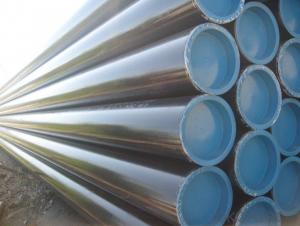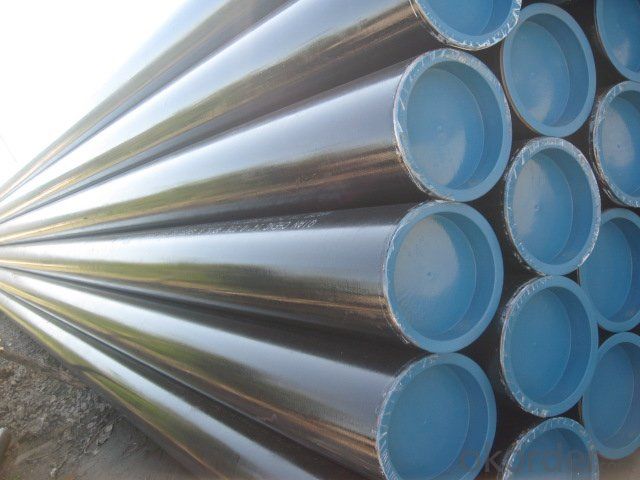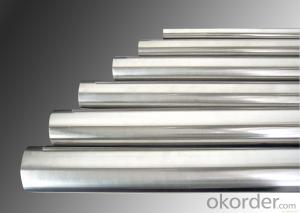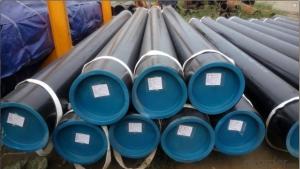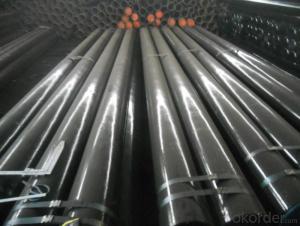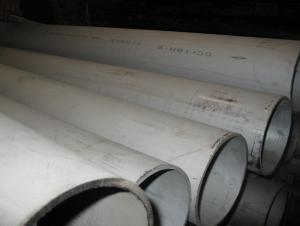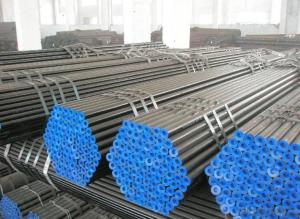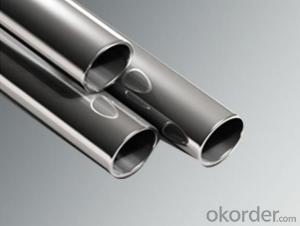Blacked Coated Hot Rolled High Carbon Seamless Steel Pipe
- Loading Port:
- Tianjin
- Payment Terms:
- TT OR LC
- Min Order Qty:
- 35 m.t.
- Supply Capability:
- 5000 m.t./month
OKorder Service Pledge
OKorder Financial Service
You Might Also Like
Specification
Blacked Coated Hot Rolled High Carbon Seamless Steel Pipe
1.Structure of Hot Rolled High Carbon Seamless Steel Pipe:
Seamless pipe is formed by drawing a solid billet over a piercing rod to create the hollow shell. As the manufacturing process does not include any welding, seamless pipes are perceived to be stronger and more reliable. Historically seamless pipe was regarded as withstanding pressure better than other types, and was often more easily available than welded pipe.
2.Main Features of the Hot Rolled High Carbon Seamless Steel Pipe:
• High manufacturing accuracy
• High strength
• Small inertia resistance
• Strong heat dissipation ability
• Good visual effect
• Reasonable price
3.Hot Rolled High Carbon Seamless Steel Pipe Specification:
Standard | GB, DIN, ASTM ASTM A106-2006, ASTM A53-2007 |
Grade | 10#-45#, 16Mn 10#, 20#, 45#, 16Mn |
Thickness | 8 - 33 mm |
Section Shape | Round |
Outer Diameter | 133 - 219 mm |
Place of Origin | Shandong, China (Mainland) |
Secondary Or Not | Non-secondary |
Application | Hydraulic Pipe |
Technique | Cold Drawn |
Certification | API |
Surface Treatment | factory state or painted black |
Special Pipe | API Pipe |
Alloy Or Not | Non-alloy |
Length | 5-12M |
Outer Diameter | 21.3-610mm |
Grade | 20#, 45#, Q345, API J55, API K55, API L80, API N80, API P110, A53B |
Standard | ASME, ASTM |
1) Material:20#(ASTM A 106/A53 GRB.API5LGRB,GB),45#,16Mn,10#.
2) Specification range:OD:21.3-610mm,WT:6-70mm,length:6-12m or according to the requirement of clients.
3) Excutive standards:GB,ASME API5L.ASTM A 106/A53,Despite of the above standards,we can also supply seamless steel pipe with standard of DIN,JIS,and so on,and also develop new products according to the requirements of our clients!
4) Surface:black lacquered,varnish coating or galvanized.
5) Ends:Beveled or square cut,plastic capped,painted.
6) Packing:bundles wrapped with strong steel strip,seaworthy packing.
4. Packing and Delivery:
Packaging Details: | seaworthy package,bundles wrapped with strong steel strip |
Delivery Detail: | 50-60days after received 30%TT or Original LC |
5. FAQ of Hot Rolled High Carbon Seamless Steel Pipe
A. How is the quality of your products?
Our products are manufactured strictly according to national and internaional standard, and we take a test on every pipe before delivered out. If you want see our quality certifications and all kinds of testing report, please just ask us for it.
Guaranteed: If products’ quality don’t accord to discription as we give or the promise before you place order, we promise 100% refund.
B. How about price?
Yes, we are factory and be able to give you lowest price below market one, and we have a policy that “ for saving time and absolutely honest business attitude, we quote as lowest as possible for any customer, and discount can be given according to quantity”,if you like bargain and factory price is not low enough as you think, just don’t waste your time.Please trust the quotation we would give you, it is professional one.
C. Why should you chose us?
Chose happens because of quality, then price, We can give you both.Additionally, we can also offer professional products inquiry, products knowledge train(for agents), smooth goods delivery, exellent customer solution proposals.Our service formula: good quality+good price+good service=customer’s trust
SGS test is available, customer inspection before shipping is welcome, third party inspection is no problem.
Any question, pls feel free to contact us !
6.Hot Rolled High Carbon Seamless Steel Pipe Images:
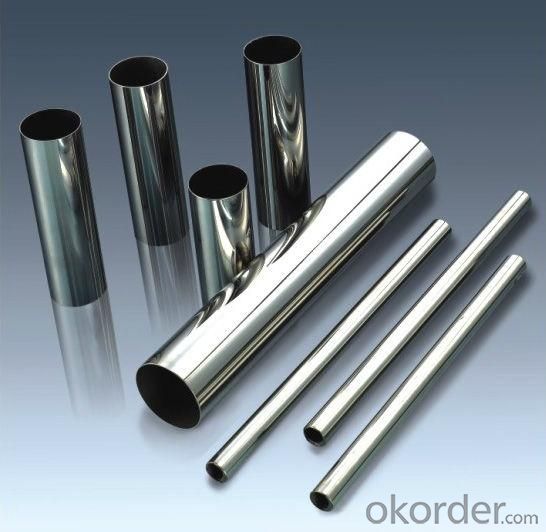
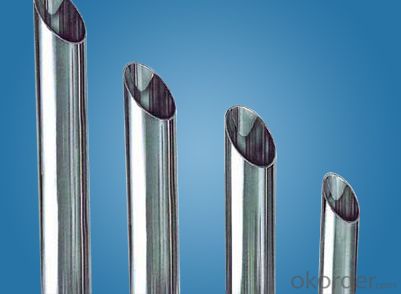
7. Company Information:
CNBM International Corporation (CNBM International) is the most important trading platform of CNBM Group Corporation, a state-owned company under the direct supervision of State-owned Assets Supervision and Administration Commission of the State Council.
Since 2004, the trading volume of CNBM International has been doubled in 5 successive years owing to the support of superior corporations and effort of all staff. Meanwhile, we have established strategic partnerships with hundreds of domestic manufacturers and sound business relations with clients from over 120 countries. In line with the business, CNBM International launched E-business platform Okorder.com.Our goal is to transform CNBM International into the global leading brand in building materials industry within 3 to 5 years through innovation and reform, by strengthening the overall management of supply chain, developing and cultivating both domestic and overseas market, improving the procedure and information system, enhancing the ability to organize resources and to provide value-added services under a professional team and a learning organization.
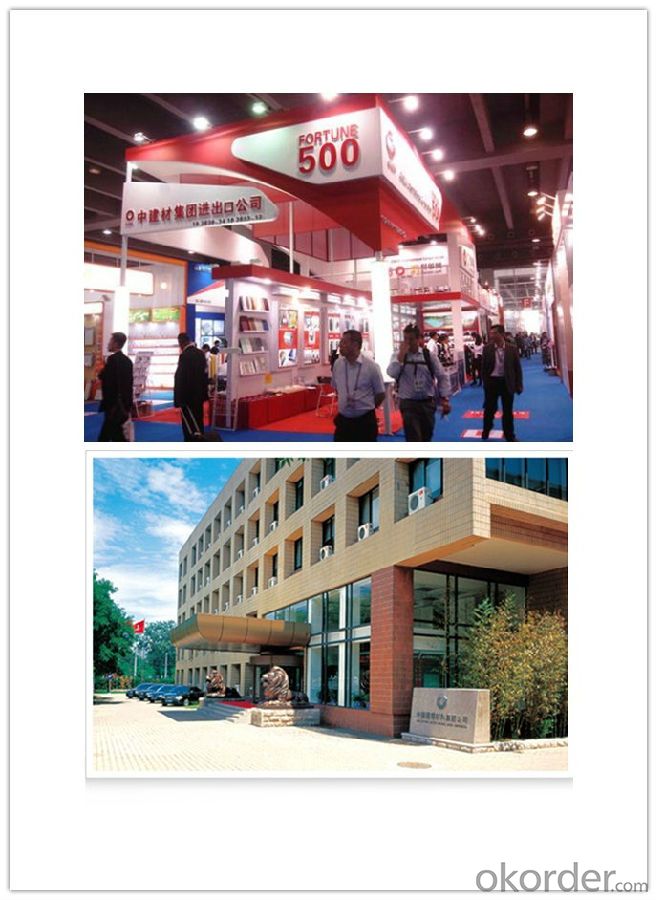
- Q: What is the difference between steel pipes and PVC-O pipes?
- Steel pipes and PVC-O pipes differ in their material composition, strength, durability, and installation process. Steel pipes are made of steel, which makes them strong and suitable for high-pressure applications. However, they are prone to corrosion and require additional coating for protection. On the other hand, PVC-O pipes are made of a specially formulated, high-strength PVC material, which provides excellent resistance to corrosion, chemicals, and abrasion. PVC-O pipes are also lighter, easier to handle, and have a longer lifespan compared to steel pipes. Additionally, PVC-O pipes are installed using a jointing system, eliminating the need for welding or threading like steel pipes.
- Q: What are the common applications of galvanized steel pipes?
- Galvanized steel pipes are commonly used in various industries and applications such as plumbing, water supply systems, gas pipelines, electrical conduits, construction projects, fencing, and outdoor structures. The galvanization process adds a protective zinc coating to the steel, making it resistant to corrosion and extending its lifespan, making it ideal for applications requiring durability and longevity.
- Q: How are steel pipes installed underground?
- Steel pipes are installed underground through a process called trenchless installation or open trench excavation. In trenchless installation, a drilling machine creates a tunnel underground, and the steel pipes are then inserted into the tunnel using a technique called pipe jacking or horizontal directional drilling. In open trench excavation, a trench is dug, and the steel pipes are laid in the trench before being covered with backfill material.
- Q: How are steel pipes used in the manufacturing of railways?
- Steel pipes are used in various ways in the manufacturing of railways. One of the primary uses of steel pipes in this context is for the construction of the railway track itself. Steel pipes are used to create the rail tracks that form the foundation of the railways. These pipes are typically welded together to form long, sturdy tracks that can withstand the weight and pressure of trains passing over them. Steel pipes are also used in the manufacturing of railway bridges and tunnels. These structures require strong and durable materials to ensure the safety and stability of the railway system. Steel pipes are often used in the construction of the support structures or piers that hold up the bridges. They are also used in the creation of tunnels, providing structural support and stability. Additionally, steel pipes are used in the manufacturing of various railway components and equipment. For example, steel pipes are used in the fabrication of railway signaling systems, which are responsible for controlling the movement of trains and ensuring safety. These pipes are often used to house and protect the electrical wiring and other components of the signaling systems. Furthermore, steel pipes are used in the manufacturing of railway carriages and locomotives. These pipes are used to create the framework and structure of the train, providing strength and stability. They are also used for various other purposes, such as the creation of air conditioning systems, brake systems, and fuel delivery systems within the train. Overall, steel pipes play a crucial role in the manufacturing of railways. They are used for the construction of rail tracks, bridges, tunnels, and various railway components and equipment. The strength and durability of steel make it an ideal material for ensuring the safety and efficiency of railway systems.
- Q: How to distinguish between steel pipe and spiral pipe material?
- Steel pipe according to the pipe material (ie steel) can be divided into: carbon tube and alloy tube, stainless steel tube.Carbon tube can be divided into ordinary carbon steel tube and high quality carbon structure tube.
- Q: How are steel pipes classified based on their end connections?
- Steel pipes can be classified based on their end connections into threaded, socket weld, butt weld, and flanged connections.
- Q: Are steel pipes suitable for underground installations in areas with high moisture content?
- In areas with high moisture content, steel pipes are commonly used for underground installations. However, it is important to consider certain factors when utilizing steel pipes in such conditions. Prolonged exposure to moisture can lead to corrosion, which is a significant concern. To mitigate this risk, it is crucial to employ steel pipes that are specifically designed for underground installations and are coated with protective materials like epoxy or polyethylene. These protective coatings act as a barrier between the steel and the surrounding moisture, preventing corrosion and prolonging the lifespan of the pipes. Furthermore, proper installation techniques, including sufficient pipe bedding and backfilling, must be adhered to in order to ensure that the pipes are adequately supported and shielded from external forces. Regular inspection and maintenance are also advisable to promptly identify any signs of corrosion or damage and address them accordingly. Overall, by taking the appropriate precautions and conducting regular maintenance, steel pipes can be a viable choice for underground installations in areas with high moisture content.
- Q: How are steel pipes used in the construction of coal-fired power plants?
- Steel pipes are commonly used in the construction of coal-fired power plants for various purposes. They are utilized for transporting coal and other fuels, as well as for carrying water and steam in the power generation process. Steel pipes are also used in the construction of the plant's cooling system, helping to circulate water and dissipate heat. Additionally, they are employed in the construction of the plant's exhaust system, facilitating the removal of combustion byproducts. In summary, steel pipes play a crucial role in the infrastructure of coal-fired power plants, enabling efficient fuel transportation, heat exchange, and waste management.
- Q: What is the role of steel pipes in the transportation of chemicals?
- Steel pipes play a crucial role in the transportation of chemicals due to their high strength and durability. They are used to safely transport a wide range of chemicals, including corrosive and hazardous substances, without the risk of leakage or contamination. The corrosion-resistant properties of steel pipes ensure the integrity of the chemicals being transported, preventing any potential damage to the environment or human health. Additionally, steel pipes can withstand high pressure and extreme temperatures, making them ideal for the efficient and reliable transportation of chemicals over long distances.
- Q: How do you calculate the pipe friction loss coefficient for steel pipes?
- To determine the pipe friction loss coefficient for steel pipes, it is necessary to take into account several factors. One commonly used approach is the utilization of the Darcy-Weisbach equation, which establishes a relationship between the frictional head loss in a pipe and the flow rate, pipe diameter, pipe length, fluid properties, and the pipe roughness coefficient. The Darcy-Weisbach equation can be presented as follows: The head loss due to friction, denoted as hf, can be calculated using the formula (f * L * V^2) / (2 * g * D), where: - f represents the pipe friction factor, - L corresponds to the pipe length, - V denotes the fluid velocity, - g symbolizes the acceleration due to gravity, and - D represents the pipe diameter. Determining the pipe friction factor, f, is crucial. For steel pipes, this factor relies on the pipe roughness coefficient, which indicates the relative roughness of the pipe. The relative roughness is determined by dividing the absolute roughness of the pipe surface by the pipe diameter. The pipe roughness coefficient can be obtained from different sources, including manufacturer specifications, engineering handbooks, or experimental data. It is imperative to ensure that the roughness coefficient used aligns with the specific type and condition of the steel pipe under analysis. Once the pipe roughness coefficient is obtained, it can be employed to calculate the pipe friction factor through empirical correlations or charts. These correlations often involve the Reynolds number, a dimensionless quantity that characterizes the flow regime. By substituting the determined pipe friction factor into the Darcy-Weisbach equation, it becomes possible to calculate the head loss due to friction for steel pipes. This value is indispensable in the design of piping systems, determination of pump requirements, or estimation of energy consumption in fluid flow applications.
Send your message to us
Blacked Coated Hot Rolled High Carbon Seamless Steel Pipe
- Loading Port:
- Tianjin
- Payment Terms:
- TT OR LC
- Min Order Qty:
- 35 m.t.
- Supply Capability:
- 5000 m.t./month
OKorder Service Pledge
OKorder Financial Service
Similar products
Hot products
Hot Searches
Related keywords
